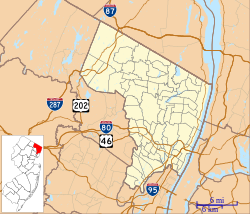History
The home was built in 1869 by Floyd W. Tomkins who called it "Hill House". It was purchased in 1887 by David Brinkerhoff Ivison who greatly expanded it and gave the home the name "Iviswold". The expansion was designed by Cornell architect William Henry Miller. Ivison died in 1903 and Iviswold was sold and resold multiple times. During this period the building was used by the Rutherford Union Club. [5]
In 1930 the building was owned by the Rutherford National Bank, then headed by Fairleigh S. Dickinson. [6] In 1942 Fairleigh Dickinson University was created and held the first classes within Iviswold. As the university grew it built multiple college buildings around Iviswold, but by the late 1980s the college was outgrowing their Rutherford campus, which was closed in 1994 and sold along with Iviswold to Felician University in 1997. Felician University spent several years restoring the building to its original condition for use as a student center. [7] The New Jersey Historic Trust contributed $1,550,000 to the restoration project. [5]
Construction
The original home was a two-story stone house with a mansard roof. The 1887 remodeling of the house was inspired by the Château de Chaumont in Loir-et-Cher, France. [5] The remodeling turned the building into a three-story turreted mansion with 25 rooms, including balconies, a music room and a porte-cochère. Local brownstone was used in the construction of the exterior walls. [5]
In the 1930s, an indoor pool was installed with a water tower built into the structure to supply it. In the 1970s, when Fairleigh Dickinson was using the building for classroom space, the college covered up much of the original interior with drop ceilings and partition walls. [5]
Felican College led renovations of the building, with exterior work taking place from 2000 to 2006 and interior work continuing until 2014. Among other things, the project involved re-installing cylindrical towers, stained glass windows, exterior masonry, the building's Ludowici clay tile roof, and ornate plaster reliefs. [8]
This page is based on this
Wikipedia article Text is available under the
CC BY-SA 4.0 license; additional terms may apply.
Images, videos and audio are available under their respective licenses.

